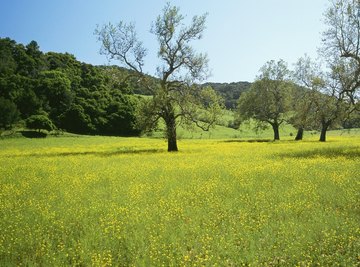
Trees are simply one kind of plant, sharing with other plants a limited range of motion, cell walls containing cellulose and the ability to change sunlight into food through photosynthesis. Within the botanical division of plants, called by the Latin term "plantae" as opposed to animals or "animalia," subcategories exist that distinguish between trees and plants. Trees and plants look different from one another, but some of their differences are detectable only by looking inside the organisms.
Overall Characteristics
While both trees and plants usually have a vascular structure, with roots, stems and leaves transporting food and water throughout the plant, plants typically have multiple soft or slightly woody stems while trees have one hard, woody and tall trunk with few leaves or branches on the lower section. Plants have leaves close to the ground or they consist entirely of leaves, as with grasses and ferns.
Shapes and Sizes
Trees appear in a variety of basic forms, from columnar types to pyramid-shaped trees to spreading and rounded forms. They vary in size from dwarf trees that may grow only 10 feet tall or look like shrubs to tall trees such as giant sequoias (Sequoiadendron giganteum) that may grow up to 260 feet tall in U.S. Department of Agriculture plant hardiness zones 6 through 9. Plants live closer to the earth and appear in forms such as grasses, mosses, shrubs, mats and clumps.
Survival Strategies
Plants fall into "ruderal," "circumventor" or stress-tolerant categories. Ruderals, including annual and perennial plants, create many seeds that reproduce quickly. Circumventors, including both plants and trees, are less prolific in seed production, more tolerant of their surroundings than ruderals and have some protection against disease and pests. Stress tolerant plants and trees thrive with little water and no fertilizer. They also protect themselves from predators with bark and resins that kill certain insects and inhibit diseases.
Lifespan Differences
Plants live for shorter periods than trees -- annuals live for only one growing season, bi-annuals for two seasons and perennials anywhere from five years to 100 years, such as in the case of lilacs (Syringa oblata, hardy in USDA zones 3 through 6). Trees typically live for 100 to 150 years, with some hardwoods living up to 200 years and conifers up to 300 years or more.
References
- Encyclopedia of Life: Plants
- Encyclopedia of Life: Animalia
- The New Sunset Western Garden Book; Kathleen Norris Brenzel, Editor
- Cal Poly San Luis Obispo Urban Forest Ecosystems Institute: Giant Sequoia
- Las Pilitas Nursery: Definition of Plant Strategies
- American Forests: The Language of Bark
- Missouri Botanical Garden: Syringa Oblata
About the Author
Susan Lundman began writing about her passions of cooking, gardening, entertaining and recreation after working for a nonprofit agency, writing grants and researching child development issues. She has written professionally for six years since then. Lundman received her M.A. from Stanford University.
Photo Credits
Medioimages/Photodisc/Photodisc/Getty Images
